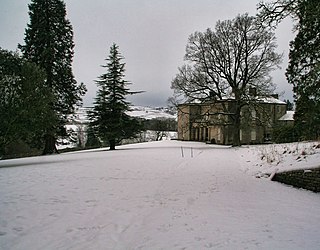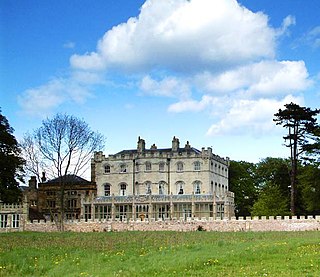
Hylton Castle is a stone castle in the North Hylton area of Sunderland, Tyne and Wear, England. Originally built from wood by the Hilton family shortly after the Norman Conquest in 1066, it was later rebuilt in stone in the late 14th to early 15th century. The castle underwent major changes to its interior and exterior in the 18th century and it remained the principal seat of the Hylton family until the death of the last Baron in 1746. It was then Gothicised but neglected until 1812, when it was revitalised by a new owner. Standing empty again until the 1840s, it was briefly used as a school until it was purchased again in 1862. The site passed to a local coal company in the early 20th century and was taken over by the state in 1950.

Woolley Hall is a country house in Woolley, West Yorkshire, England. It is a Grade II* listed building.
Cotheridge Court is a Grade II* listed ancient manor house situated in the south-western part of Cotheridge, in the county of Worcestershire, England, and birthplace of Herbert Bowyer Berkeley. The house bought in 1615 by William Berkeley, eldest son of Rowland Berkeley (1548-1611) of Spetchley, was owned and lived in by the Berkeley family for nearly 350 years, but the manor is over one thousand years old. This family descended from the Berkeleys of Berkeley Castle Gloucestershire, and Eadnoth. Cotheridge Court is now a private residence of sub-divided flats.
Hebburn Hall also known as Ellison Hall is a 17th-century country mansion, which has been converted into residential apartments and houses, situated at Hebburn, South Tyneside, Tyne and Wear. It is a Grade II listed building.

Whitworth Hall which stands in Whitworth Hall Country Park, near Spennymoor, County Durham England, is a country house, formerly the home of the Shafto family and now a hotel. It is a listed building.

Beamish Hall is a mid-18th-century country house, now converted to a hotel, which stands in 24 acres (97,000 m2) of grounds near the town of Stanley, County Durham. It is a Grade II* listed building.

Eggleston Hall is a privately owned 19th-century English country house in Eggleston, Teesdale, County Durham. It is a Grade II* listed building.

Lartington Hall is a 17th-century country house, at Lartington, Teesdale, County Durham, England. It is a Grade II* listed building.
Whitwell Old Hall is an early 17th-century manor house at Whitwell, Derbyshire. It is a Grade II* listed building.
Thornton Watlass Hall is a large Grade I listed Georgian country house in Thornton Watlass, North Yorkshire, England, some 3 miles (5 km) north of Masham.

Onesacre Hall is a Grade II* Listed building situated in the rural outskirts of the City of Sheffield in South Yorkshire, England. The hall is located on Green Lane in the small hamlet of Onesacre in the suburb of Oughtibridge, 5 miles (8.5 km) north west of the city centre.

Gainford Hall is a privately owned Jacobean manor house at Gainford, County Durham. It is a Grade I listed building but as of 2014 is registered as a Building at Risk.

Biddick Hall is a small privately owned 18th-century country mansion at Bournmoor, County Durham, near the City of Sunderland and Chester-le-Street. It is a Grade I listed building and the home of the Lambton family.

The Castle at Castle Eden, County Durham, England, is an 18th-century, Palladian style, mansion house and a Grade II* listed building. No trace remains of the medieval castle of Robert the Bruce.

Carnfield Hall is a privately owned country house located at South Normanton, near Alfreton in Derbyshire, England. It is a Grade II* listed building. The estate includes around ninety acres of park and ancient woodland.

Bosworth Hall actually consists of two houses, the Old Hall and a newer Georgian-style hall, situated in Theddingworth Road, Husbands Bosworth, Leicestershire. The Old Hall, originally constructed in Norman times, was substantially renovated in the 16th century as a west facing country house. The new and additional Georgian hall was then built facing south west, adjoining the older house, in about 1790. In about 1870 a Victorian Gothic wing was created to link the two buildings. The whole is a Grade II* listed building.
Lymm Hall is a moated country house in the village suburb of Lymm in Warrington, Cheshire, England. It is recorded in the National Heritage List for England as a designated Grade II* listed building.

Aston Bury is a manor house near Aston, Hertfordshire, England. It is Grade I listed building.

Richhill Castle is a 17th-century Grade A listed country house in the large village of Richhill, in the townland of Legacorry, Armagh, Northern Ireland, roughly halfway between Armagh and Portadown.

Nappa Hall is a fortified manor house in Wensleydale, North Yorkshire, England, described by English Heritage as "probably the finest and least-spoilt fortified manor house in the north of England". It stands 1-mile (1.6 km) east of Askrigg, overlooking pastures leading down to the River Ure. A single-storey central hall sits between two towers, a four-storey western tower and a two-storey eastern tower. The four-storey tower has a turret, lit by slit vents, for a spiral staircase that climbs to crenellated parapets. The taller tower retains its original windows, but sash windows were inserted in the 18th century in the lower two-storey block which housed the kitchen and service rooms, at the opposite end of the hall. In the 17th century, an extra wing was added. The battlements are served by a single stair consisting of 70 stone steps.















